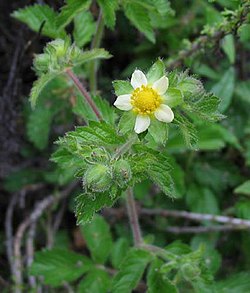| Drymocallis | |
|---|---|
 | |
| Sticky cinquefoil, Drymocallis glandulosa | |
| Scientific classification | |
| Kingdom: | Plantae |
| Clade: | Tracheophytes |
| Clade: | Angiosperms |
| Clade: | Eudicots |
| Clade: | Rosids |
| Order: | Rosales |
| Family: | Rosaceae |
| Subfamily: | Rosoideae |
| Tribe: | Potentilleae |
| Subtribe: | Fragariinae |
| Genus: | Drymocallis Fourr. ex Rydb. |
| Species | |
At least 3; see text | |
Drymocallis is a genus of plants formerly (and sometimes still) included with the typical cinquefoils (Potentilla). It contains three species known or suspected to be protocarnivorous, [1] but more cinquefoils might eventually be moved here: [2] [3]